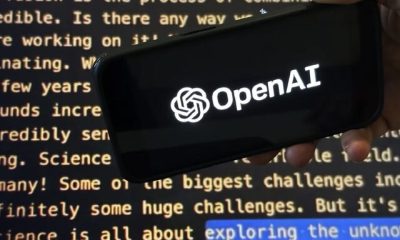Technology
What is artificial intelligence? ChatGPT and Dall-E technology
Published
1 year agoon


From ChatGPT to Dall-E and the new Bing; These are all based on artificial intelligence. But what exactly is artificial intelligence and how do the new wonders of the technology world work?
What is artificial intelligence? ChatGPT and Dall-E technology
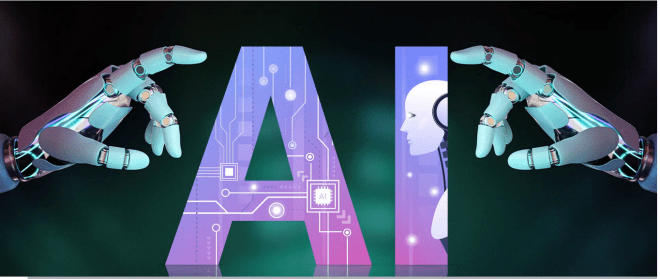

Artificial intelligence or AI is everywhere these days. “Intractable” problems are being solved; People with no knowledge of coding or composing or designing can build websites and songs in seconds with the help of AI and create amazing artwork. Big companies are also investing billions of dollars in AI projects, and by bringing the ChatGPT chatbot to Bing, Microsoft is trying to overturn our search model on the Internet and maybe even disrupt the entire structure of the Internet in some time.
Getting your head around AI, like any new technology that comes with a lot of hype and media controversy, can be confusing, and even experts in artificial intelligence can hardly keep up with the momentary developments of this technology.
Read More: The dark side of longevity prediction technology
In the field of AI, a series of questions are asked; For example, what exactly is meant by artificial intelligence? What is the difference between artificial intelligence, machine learning, and deep learning? What difficult problems can be easily solved now, and what problems are still beyond the capabilities of artificial intelligence? And perhaps the most popular of them; Is the world going to be destroyed by artificial intelligence?
If you have also been asked why there is so much fuss and excitement about artificial intelligence, and if you would like to learn the answers to these questions in simple language, join us to take a look behind the curtain of this mysterious and powerful technology.
What is AI?
The term “Artificial Intelligence” or AI is used to describe a system that can perform cognitive activities related to the human mind, such as “learning” and “problem solving” as well or even better than humans. But in most cases, what we know as artificial intelligence is actually called “Automation” or the process of automation, and to better understand AI, we must first understand its difference from automation.
There’s an old joke in the computer science world that automation is what we can do with computers right now, but artificial intelligence is what we wish we could do with computers. In other words, as soon as we understand how to do something with a computer, we leave the field of artificial intelligence and enter automation. The reason for this joke is that artificial intelligence does not have a precise definition and is not even a technical term. If you look at Wikipedia, you’ll read that artificial intelligence is “intelligence developed by machines, as opposed to natural intelligence exhibited by animals, including humans.” It means such a vague and broad definition.
In general, there are two types of artificial intelligence: strong AI and weak AI.
Strong artificial intelligence is what most people imagine when they hear AI; That is, a type of omniscient intelligence similar to the character of Hal 9000, the same killer robot in the movie Space Odyssey or the self-aware artificial intelligence system of Skynet in the Terminator movies, which, while having superhuman intelligence and the ability to reason and think logically, also have abilities beyond humans.
In contrast, weak AI is highly specialized algorithms that are designed to answer specific, useful questions and are limited to the same problem; Like Google and Bing search engine, Netflix movie suggestion algorithm, or even Siri and Google Assistant voice assistant. These AI models are very impressive at their level, although their efficiency is limited.
But Hollywood sci-fi movies aside, we are still a long way from achieving strong AI. Currently, all the AIs we know are weak, and some researchers believe that the methods that have been used to develop weak artificial intelligence will not be applicable to the development of strong artificial intelligence. Of course, if you ask the opinion of the employees of OpenAI, the developer of the popular chatbot ChatGPT, they will tell you that in the next 13 years and with the same known methods, they can achieve strong AI!
If we want to be very precise in this matter, we must say that “artificial intelligence” is currently more of a term for attracting attention and marketing than a technical term. The reason why companies use artificial intelligence instead of using the word “automation” is because they want to conjure up in our minds the same sci-fi images from Hollywood movies. But this work is not completely clever and deceitful; If we want to joke, we can say that these companies intend to say that it is true that we have a long way to go before we reach strong artificial intelligence, but the current weak AI should not be underestimated, because it has become many times stronger than a few years ago. Well, that is absolutely true.
In some fields, there have been dramatic changes in the ability of machines, and that is due to the advances that have been made in the last few years in two fields related to AI, namely machine learning and deep learning. You have probably heard these two terms a lot, and we will explain their mechanism below. But before that, let’s talk a little about the interesting and readable history of artificial intelligence.
History of artificial intelligence
Can machines think?
In the first half of the 20th century, science fiction introduced people to the concept of intelligent robots, the first of which was the character of the Tin Man in the novel “The Wizard of Oz” (1900). It wasn’t until the 1950s that we had a generation of scientists, mathematicians, and philosophers whose minds were engaged with the concept of artificial intelligence. One of these people was an English mathematician and computer scientist named Alan Turing, who tried to investigate the possibility of achieving artificial intelligence with mathematical science.
Turing said that humans use available information as well as the power of reasoning to make decisions and solve problems, so why can’t machines do the same? This mental preoccupation eventually led to the writing of a very famous paper in 1950 that posed the controversial question, “Can machines think?” was starting In this article, Turing described how to build intelligent machines and test their intelligence level, and by asking “Can machines excel in the imitation game?”, he initiated the very famous “Turing Test”.
The lack of memory and the staggering costs of computers prevented Turing from testing his theory
But Turing’s paper remained a theory for a few years because at that time computers did not benefit from the key prerequisite for intelligence; That they could not save the commands and could only execute them. In other words, computers could be told what to do, but they could not be asked to remember what they had done.
The second big problem was the skyrocketing costs of working with computers. In the early 1950s, the cost of renting a computer reached 200,000 dollars per month; For this reason, only prestigious universities and large technology companies could enter this field. In those days, if someone wanted to receive funding for artificial intelligence research, it was necessary to first prove the feasibility of his idea and then get the support and approval of influential people.
The historic DSRPAI conference that started it all
Five years later, three computer science researchers named Ellen Newell, Cliff Shaw, and Herbert Simon developed the Logic Theorist software, which was able to prove the possibility of Turing’s idea of machine intelligence. Developed with funding from RAND, the program was designed to mimic human problem-solving skills.
Logic Theorist is considered by many to be the first artificial intelligence program. It was presented at the Dartmouth College Summer Research Project on Artificial Intelligence (DSRPAI) hosted by John McCarthy and Marvin Minsky in 1956.
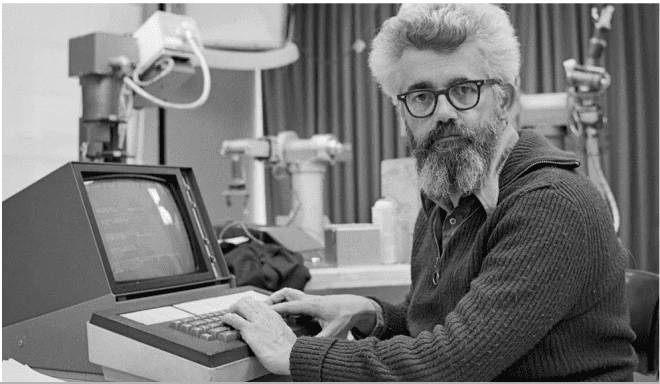

John McCarthy is known as the father of artificial intelligence
In this historic conference, McCarthy brought together top researchers in various fields for an open discussion about artificial intelligence (a term McCarthy himself coined at the same event), with the idea that artificial intelligence could be achieved through collective collaboration. But the conference could not meet McCarthy’s expectations, because there was no coordination between the researchers; They came and went as they pleased and did not reach any agreement on standard methods for conducting AI research. However, all participants felt wholeheartedly that AI is achievable.
The importance of the DSRPAI conference is indescribable; Because 20 years of research in the field of artificial intelligence was based on it.
The rollercoaster of successes and failures of artificial intelligence
From 1957 to 1974, is known as the heyday of artificial intelligence. During this period, computers became faster, cheaper, more ubiquitous, and could store more information. Machine learning algorithms also improved and people knew better which algorithm to use to solve which problem.
Examples of early computer programs such as Newell and Simon’s General Problem Solver or the ELIZA software designed by Joseph Weisenbaum in 1966 and the first chatbot to successfully pass the Turing test, respectively, take scientists a few steps closer to the goals of “problem-solving” and “interpretation of spoken language” brought closer.
These successes, along with the support of prominent researchers who attended the DSRPAI conference, eventually convinced government agencies such as the US Defense Advanced Research Projects Agency (DARPA) to fund AI research at several institutions. The US government was particularly interested in developing a machine that could transcribe and translate both spoken language and data processing at high throughput.
At this time, researchers were very optimistic about the future of this field and their level of expectations was even higher than their optimism; As Marvin Minsky told Life magazine in 1970, “In three to eight years, we will have a machine with the general intelligence of a normal human.” However, although AI was proven to be feasible for everyone, there was still a long way to go before the ultimate goals of natural language processing, abstract thinking, and self-awareness in machines were achieved.
There were many obstacles on the way to the realization of these goals, the biggest of which was the lack of sufficient computing power to carry out the projects. The computers of that time did not have enough space to store a huge amount of information, nor the necessary speed to process them. Hans Morawek, McCarthy’s Ph.D. student at the time, said that “computers back then were millions of times too weak to show intelligence.” When the patience of researchers ran out, government budgets also decreased, and for ten years, the pace of artificial intelligence research slowed down.
Until the 1980s, two factors revived artificial intelligence research; Significant improvements in algorithms and the arrival of new funds.
Significant improvements in algorithms have given new life to artificial intelligence research
John Hopfield and David Rumelhart developed Deep Learning techniques that allow computers to learn new things by experimenting on their own. On the other hand, the American scientist of computer science, Edward Feigenbaum, introduced “Expert Systems” that mimic the decision-making process of experts. This system asked experts in various fields how they would react in a specific situation and then provided their answers to non-experts so that they could learn from the program.
Expert systems were widely used in industries. As part of the Fifth Generation Computing Project (FGCP), the Japanese government has invested heavily in expert systems and other artificial intelligence projects. From 1982 to 1990, Japan spent $400 million to revolutionize computer processing, implement logic programming, and improve artificial intelligence.
Unfortunately, most of these ambitious goals were not realized; But it can be seen that the Japanese FGCP project indirectly inspired a generation of young engineers and scientists to step into the world of artificial intelligence. Finally, the FGCP budget ran out and AI was once again out of the spotlight.
The defeat of the world chess champion against Deep Blue; The first big step towards the development of decision-making
AI Ironically, AI found another opportunity to grow in the absence of government funding and hype. During the 1990s and 2000s, many important goals of artificial intelligence were realized. In 1997, the chess-playing supercomputer Deep Blue made by IBM was able to defeat Garry Kasparov, the grandmaster and world chess champion.
In this match, which was accompanied by great media fanfare, for the first time in history, the world chess champion lost to a computer, and it is referred to as the first big step towards the development of an artificial intelligence program with the ability to make decisions.
In the same year, Dragon System’s speech recognition software was implemented on Windows. This was another big step in the field of artificial intelligence, but for the purposes of interpreting spoken language. It seemed that there was no problem that machines could not solve. Even human emotions were opened to machines; The Kismet robot, created in the 1990s by Cynthia Breazeal at MIT, could understand and even display emotions.
Time; The best soloution for all the problems
Scientists still use the same methods for programming artificial intelligence as they did decades ago; But what happened now that we have reached such impressive achievements as ChatGPT chatbot and Dall-E image generator and Midjourney?
The answer is that engineers finally managed to solve the problem of computer storage limitations. Moore’s Law, which estimates that the memory and speed of computers will double every year, finally happened and even exceeded this limit in many cases. In fact, the reason for the defeat of Garry Kasparov in 1997 and the defeat of the Go board game champion Ke Jie in 2017 against Google’s AlphaGo program is due to this increase in computer speed and memory. This theorem explains the process of artificial intelligence research; we develop AI capabilities to the current level of computing power (in terms of processing speed and storage memory) and then wait for Moore’s Law to catch up with us again.
We are now living in the age of “big data”; An era in which we have the ability to collect a huge amount of information that is extremely difficult and time-consuming to process of them by humans. The use of artificial intelligence in various industries such as technology, banking, marketing, and entertainment has solved this difficulty to a large extent. The large language models used in the ChatGPT chatbot showed us that even if the algorithms are not very advanced, big data and massive computing can help AI learn and improve its performance.
There may be some evidence that Moore’s Law is slowing down, especially in the world of chips, but the growth of information is moving at breakneck speed. Advances in computer science, mathematics, or neuroscience can all push humanity past the limits of Moore’s Law. And this means human progress in artificial intelligence technology will not end soon.
Types of artificial intelligence
AI is categorized in different ways; Apart from the very general classification of weak AI and strong AI that we discussed at the beginning of the article, another common method divides artificial intelligence into four categories:
1) Reactive Machines, which are the simplest type of artificial intelligence and can only respond to current situations without using past experiences; Like Google search engine.
2) Limited Memory machines that can use some past data to improve decision-making; Like the authentication system in websites.
3) Theory of Mind, which is currently a hypothetical type of artificial intelligence that can better understand the feelings, emotions, and beliefs of humans and then use this information to make their own decisions.
4) Self-aware artificial intelligence, which is another hypothetical type of artificial intelligence that has reached self-awareness and can have feelings and thoughts similar to humans.
But the most practical category of artificial intelligence, which has nothing to do with hypotheses and theories and only describes what has been achieved so far, is “Machine learning” and “Deep learning”, which are some of them in almost all intelligence systems. Today’s artificial is used.


You may like


How to install Windows 11 without a Microsoft account?
Based on Microsoft’s decision and unlike how to install Windows 10, users must enter their Microsoft email or any other account to connect their Windows user account with that person’s email for the initial setup of Windows 11; Otherwise, users will not be able to complete the Windows 11 installation process.
This means that the user must be connected to the Internet to start Windows 11, and it is not possible to create a local account. This incident resulted in the protest of many users; Because in many cases, due to the lack of necessary drivers, users could not connect to the Internet in the Windows setup interface or Out of box experience, or they did not want to enter their email at all.
However, it is not impossible to install Windows 11 without the internet. According to its usual habit, Microsoft is not strict in the field of many of its decisions and policies, and like its own solution to avoid the lack of a TPM 1.2 chip for installing Windows 11 or existing solutions for installing Windows 11 on incompatible systems, with a few simple moves, you can force the connection to the Internet and Bypasses email log in at Windows startup.
If you are one of those people who are stuck on the Internet connection or email login screen when starting Windows, with the help of this tutorial, you can easily solve your problem and complete the steps to install Windows 11 without a Microsoft account.
Windows 11 setup without internet
There are 4 ways to boot Windows 11 without the internet that still work and are very easy to do.
Bypassing the Internet connection with Bypass code
If the Windows 11 setup steps are stuck on the Let’s connect you to a network screen due to the lack of Internet connection, the Next button will be grayed out until a stable connection is established, and you will not be able to proceed to the next steps.
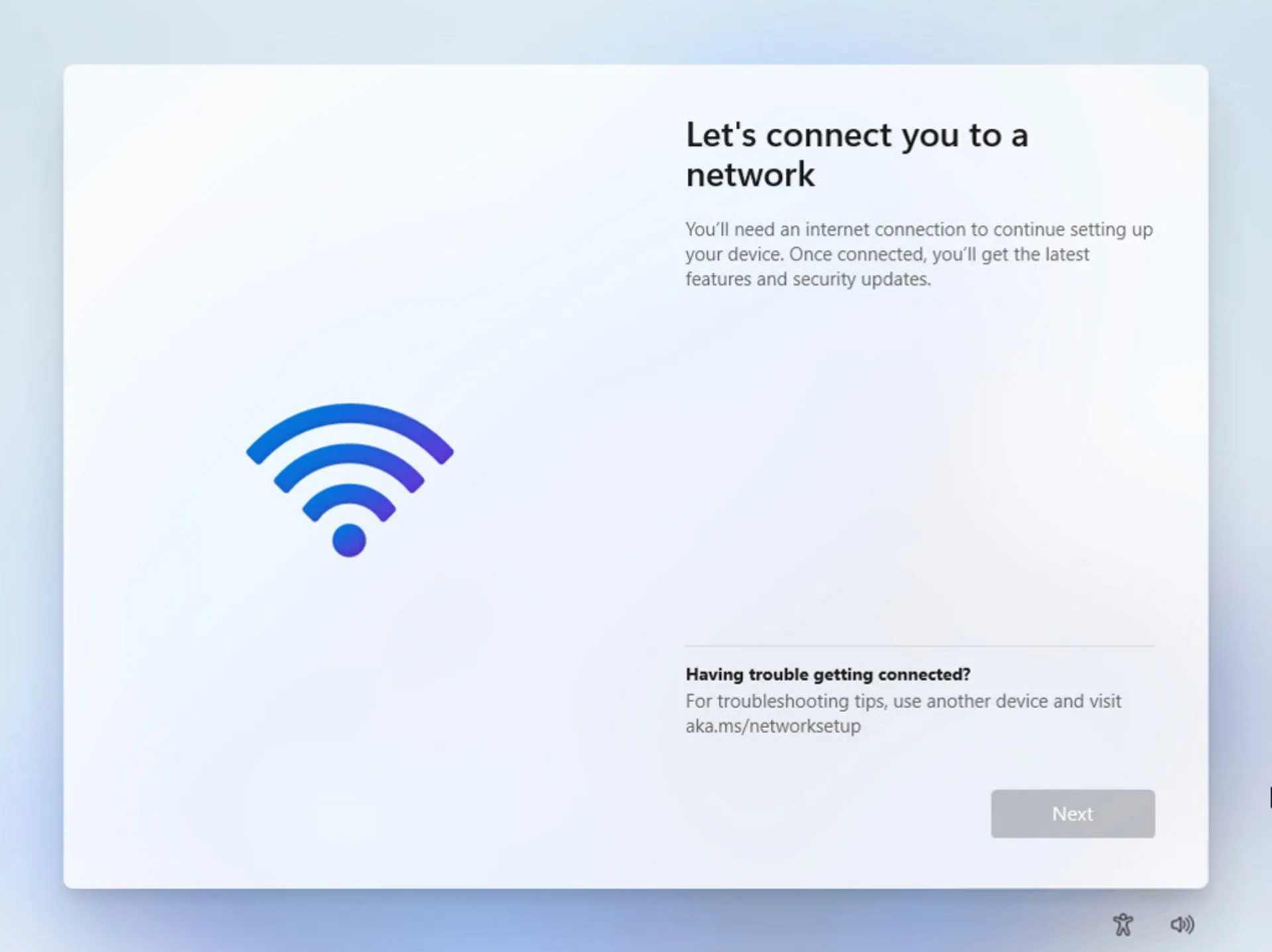
Not only in this situation but also if you need to enter the username and password through the portal to enter the network, you cannot do anything and you have to bypass this step. In this situation, follow the steps below:
- In the mentioned screen, press the Shift+F10 keys to open the command prompt window.
- Enter OOBE\BYPASSNRO and press enter.

- Next, your device will restart. Go through the setup process again until you reach the Let’s connect you to a Network page. Now, on this page, you will see that the I don’t have internet option has been added next to the Next option. Click on it.
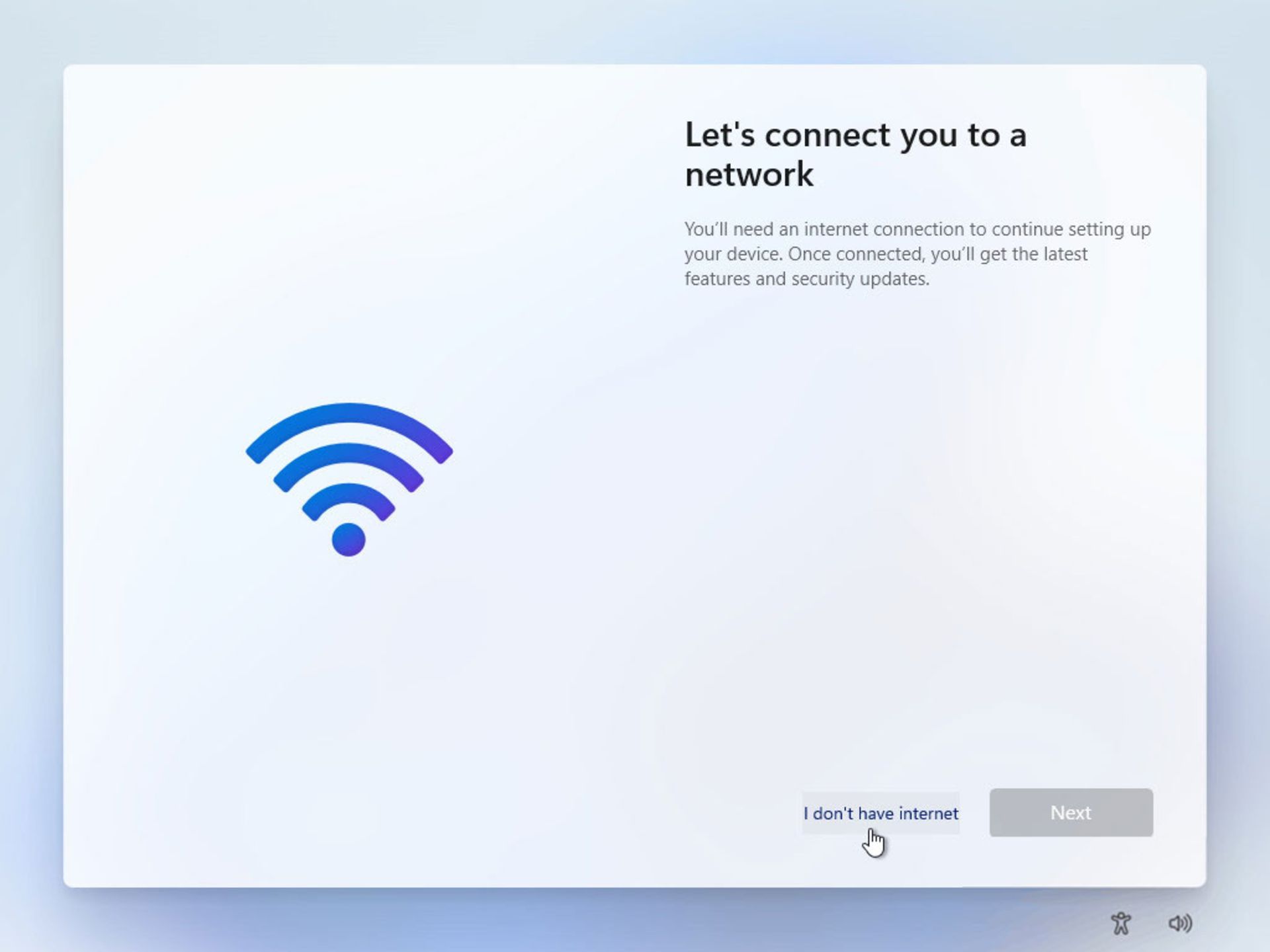
- On the next page, click Continue with limited setup.

- After that, the page for creating a local account will be in front of you, and by entering the desired name and the password on the next page, the local account will be created and the Windows 11 setup process will be completed. If you leave the password box blank, the account will be created without a password.

End the connection process with the Task Manager
On the same Let’s connect you to a network page, you can delete the running process that forces you to connect to the Internet and enter the Microsoft account by running the task manager.
- Open the command line window by pressing the Shift + F10 buttons and type taskmgr and press enter to open the task manager.

- You can also open the task manager window by pressing Ctrl + Shift + Esc.
- After opening the task manager, look for Network Connection Flow in the Processes section. You can also use the search section to find it.

- Then select Network Connection Flow and click on the End task option. After that, close the task manager window and type the word exit to exit the command line window and press enter.
- Now you will be faced with loading animations and you will go directly to the local account creation section. Enter your desired name and continue the Windows setup process.
Remove the Internet connection with the command line
If you are unable to kill the internet connection process through the task manager, you can do it through the command line.
- On the Let’s Connect you to a network page, press Shift + F10 to open the command line.
- In the window that opens, enter the following code and press enter.

- After the command is executed, close the command line window and continue the Windows 11 setup process.
Skip the Internet connection page with Alt + F4 buttons
Such a method may not work for all users, but if you cannot bypass the forced Internet connection and enter the Microsoft account with any of the above methods, on the Let’s Connect you to a network page, press the Alt + F4 combination buttons to force the Internet connection window.
Read more: The best-hidden features for Windows 11
If nothing happens after pressing the mentioned buttons once, try pressing the buttons several times in a row. Alt + F4 keys in the Windows environment can also be used to close running programs or open the shutdown menu.
The above methods work in all versions of Windows 11. If you encounter any problem in performing any of the steps, share with us in the comments section.
Technology
Unveiling of OpenAI new artificial intelligence capabilities
Published
6 days agoon
14/05/2024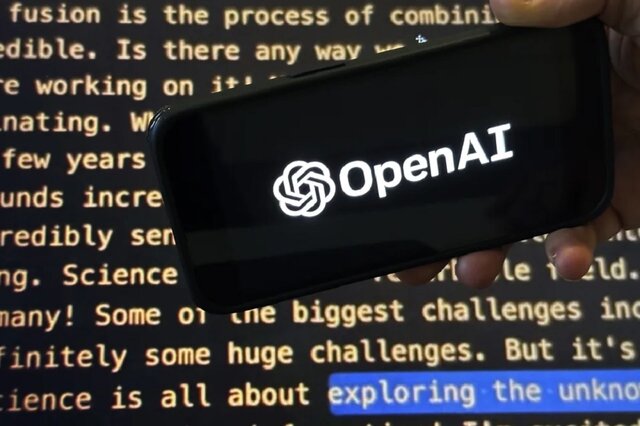

OpenAI claims that its free GPT-4o model can talk, laugh, sing, and see like a human. The company is also releasing a desktop version of ChatGPT’s large language model.
Unveiling of OpenAI new artificial intelligence capabilities


Natural human-computer interaction
What exactly does the introduction of this model mean for users?
Strong market for generative artificial intelligence




Samsung S95B OLED TV review
What can be placed in a container with a depth of 4 mm? For example, 40 sheets of paper or 5 bank cards; But to think that Samsung has successfully packed a large 4K OLED panel into a depth of less than 4mm that can produce more than 2000 nits of brightness is amazing. Join me as I review the Samsung S95B TV.
Samsung has a very active presence in the smartphone OLED display market, and by the way, it also has some of the best and most stunning small OLED panels in its repertoire; But surprisingly, it has been a little more than a year since he seriously entered the OLED TV market; Of course, Samsung launched its first OLED TV in 2013 and quickly withdrew from the large-size OLED market and left the field to its traditional and long-standing rival, LG.
In the years after withdrawing from the OLED TV market, Samsung focused on the evolution of LCD TVs with technologies such as Quantum Dot and MiniLED; But after almost 10 years, Samsung decided to once again try its luck in the world of OLEDs, and thus, in 2022, it launched the S95B TV in two 55-inch and 65-inch models.
In 2023, Samsung introduced the S95C TV as a successor to the S95B and unveiled the S95D model at CES 2024; While Samsung’s 2024 TV has just been launched in international markets a few months after its launch, it is still hard to find its 2023 model in the Iranian market. Accordingly, we have prepared the 65-inch S95B model from 2022 for review. It is more numerous than the 2023 model in the market of the country.
Slim design… super slim
What draws attention to Samsung TV at first sight is not its eye-catching image and ear-pleasing sound, but its infinite slimness. The S95B was so slim that when I unboxed and installed it, I experienced the same level of anxiety I had on exam night! Samsung OLED TV is only 3.89 mm thick; For this reason, despite all the company’s efforts in strengthening the body, it still simply shakes and sways.

Samsung calls the ultra-slim design of its TV LaserSlim; Because the laser beam is narrow and sharp; So you should be very careful when installing the TV. I wish we knew what is the logic behind the childish efforts of companies to make the world’s thinnest TV. To some extent, the narrowness of the TV helps to make it more modern and better installed on the wall; But the strength of the TV should not be sacrificed to make it thinner.

Samsung designers have not spared even the edges of the TV! The width of the edges around the panel does not exceed 8 mm. The narrowness of the edges helps the user to immerse well in the depth of black and the extraordinary contrast of the OLED TV panel and enjoy the content to the fullest.

The S95B TV has a high-quality and well-made body, the frame of the device is metal, and like most OLED TVs in the market, there is a wide plastic protrusion in the lower half of which parts such as the board, speakers, and power supply are placed. Due to this protrusion, the thickness of the body reaches 4.1 cm in the maximum state.




Unfortunately, just like LG’s OLED TVs, the base of the S95B is also located in the middle of the device; Although the base itself is metal and relatively wide; the large dimensions of the TV and its very small thickness make it not to be firmly and firmly placed on the table and not to wobble; Of course, you can install the TV on the wall with a 300×200 mm VESA mount.


All the ports of the S95B TV, including HDMI and USB, are included in the plastic protrusion on the back of the device. These ports are covered with a plastic screen to integrate and beautify the back of the device. After installing it, surprisingly, you won’t be able to access the ports! Samsung TV ports are as follows:
- Four HDMI 2.1 ports with the ability to transfer 4K120 image signal; Two ports facing down and two ports on the side of the frame
- Two USB 2.0 ports on the side of the frame
- A network port
- Internal and external receiver input
- An optical audio output
One of the HDMI ports (number 3) has eARC capability and can be used to connect the device to the soundbar. USB ports are also different in terms of current and voltage; One of the ports is limited to 0.5 amps and 5 volts and the other is limited to 1.0 amps and 5 volts; Therefore, it is considered a more reasonable option for connecting an external hard drive.
Stunning brightness and disappointing color accuracy
I mentioned earlier that we had the 65-inch S95B model available for review. With such dimensions, you can enjoy the 4K resolution of the panel the most if you sit at a distance of about 2 meters from the TV; At closer distances, pixels can be separated, and at distances greater than 2 meters, your brain’s perception of a 4K image will be no different from a 1080p image.

The Samsung S95B TV uses a 10-bit OLED panel with a resolution of 4K or 2160 x 3840 pixels and can display more than a billion colors. Supporting this number of colors is essential to provide an optimal experience of HDR content playback. In the following, I will explain more about the compatibility of Samsung TVs with HDR standards and the quality of color display.
Unlike LCD panels, where the light needed by the pixels is provided by a number of LED lights on the edge or back of the panel, in OLED panels, each pixel provides its own light; As if instead of a limited number of exposure areas, for example 500-600 in MiniLED TVs, we have more than 8 million exposure areas; Thus, to display the color black, the pixels are turned off, so that instead of a spectrum of gray color, we see a deep black and experience an extremely high contrast.
 The absence of any Blooming thanks to the precise control of light in the TV’s OLED panel
The absence of any Blooming thanks to the precise control of light in the TV’s OLED panel
The great advantage of self-lit pixels (pixels that provide their own light) in displaying deep black and preventing the Blooming phenomenon (creating a halo around bright subjects in a dark background) thanks to the very precise control of the light distribution, also has some weaknesses; The greater vulnerability to burn-in phenomenon during long-term static image display and the lower level of OLED panel brightness compared to MiniLED samples are among these weaknesses.
Like other OLED TVs, the S95B TV is not immune to the risk of burn-in. In order to reduce the possibility of this phenomenon, the Koreans have considered solutions such as moving the image slightly in different time periods. Unfortunately, we do not have the possibility to examine the TVs for a long time to evaluate their performance in preventing the risk of burn-in; But at least based on RTINGS’ long-term and unrealistic test, the S95B seems to be more vulnerable compared to its competitors; However, in real use, it is unlikely that a user would want to watch TV with such intensity.
To overcome the inherent weakness of OLED panels in achieving higher levels of brightness, Samsung engineers have combined quantum dot technology with OLED panels. Quantum dots are very small crystal particles that are layered in the heart of the display panel. With the help of the quantum dot layer, the panels achieve higher brightness and produce more vivid colors. Samsung calls its combined panel QD-OLED and claims that with the help of the Neural Quantum processor in the heart of the S95B TV, this panel can raise the brightness to a higher level than its competitors.
|
Samsung S95B 65-inch TV brightness with default settings |
||||
|---|---|---|---|---|
|
Image modes/pattern white percentage |
10 percent |
50 percent |
100 percent |
|
|
SDR |
Dynamic |
1065 |
633 |
364 |
|
Standard |
740 |
487 |
281 |
|
|
Movie |
430 |
399 |
229 |
|
|
HDR |
Dynamic |
2094 |
— |
— |
|
Standard |
2179 |
— |
— |
|
|
Movie |
2179 |
— |
— |
|
|
FILMMAKER Mode |
2175 |
— |
— |
|
In my measurements, when only 10% of the screen was lit and the device was playing a normal SDR image, the brightness of the S95B panel reached 1100 nits in the highest mode, which is a very good number and better than the brightness of the C2 and C3 TVs in the same conditions, respectively. It is about 300 and 100 nits more.
Aside from the S95B’s excellent performance in SDR image brightness, the real magic happens when the device is playing HDR video. In this situation, when 10% of the screen is lit, the brightness reaches a stunning number of about 2200 nits, which is 700 nits more than the HDR brightness of the C2 and C3 TVs. Achieving such a level of brightness helps the TV to deliver a stunning HDR movie viewing experience.
|
Comparison of brightness and contrast of S95B with other TVs |
||
|---|---|---|
|
TV/parameter (the brightest profile) |
Brightness (50% pattern) |
contrast |
|
Samsung S95B |
633 |
∞ |
|
LG C3 |
603 |
∞ |
|
LG QNED80 |
580 |
116 |
|
LG NANO84 |
295 |
149 |
|
LG C2 |
525 |
∞ |
|
LG QNED96 |
470 |
— |
Note that the stunning numbers of 1100 and 2200 nits are obtained when a small part of the screen is bright, which is often the case in movies and series, and the entire image is not full of bright colors; But when the whole screen is lit; For example, consider a scene from The Lord of the Rings where we see Galadriel in the land of the elves, in such a situation, the maximum brightness of the whole screen is about 370 nits, which is still 40 nits higher than the LG TV.

Thanks to the panel’s excellent brightness and the deep blacks produced by the muted pixels, it’s no surprise that the Samsung TV’s image contrast is superb; Especially since there is an anti-reflective coating on the panel so that you can enjoy the image even in bright environments; Note that unlike what comes from the corners of the panel, you should not remove this anti-reflective layer from the panel; Otherwise, you will face problems like us!
If you think that the S95B is the best TV on the market so far, I must say that not everything about the S95B is rosy.
The S95B TV provides the user with the following four color profiles, all of which tend to be very cold by default and do not produce very accurate colors.
- Dynamic
- Movie
- Standard
- FILMMAKER Mode
Like most OLED TVs on the market, the S95B TV also covers a wide range of colors. In my tests, the Samsung TV managed to cover about 148% of the sRGB color space, nearly 100% of the DCI P3 wide space, and 75% of the Rec 2020 ultra-wide space. These numbers are great, But the disappointing thing is the very low accuracy of the device in producing the mentioned colors with factory settings.
|
Samsung S95B 65-inch TV performance in covering color spaces with default settings |
||||||
|---|---|---|---|---|---|---|
|
Image mode/color space |
sRGB |
DCI-P3 |
Rec. 2020 |
|||
|
cover |
mean error |
cover |
mean error |
cover |
mean error |
|
|
Dynamic |
146 |
— |
98.6 |
13.7 |
77.9 |
— |
|
Standard |
147.7 |
— |
99.7 |
12.1 |
78.7 |
— |
|
Movie |
125.4 |
— |
89.5 |
4.6 |
65.5 |
— |
|
FILMMAKER Mode |
121.9 |
— |
89.5 |
4.1 |
64.6 |
— |
Note that the FILMMAKER mode belongs to the UHD union and most big companies like Samsung, LG and Hisense use it in their TVs. On paper, with FILMMAKER mode, we should see movies as the director intended.
|
Comparison of Samsung S95B color accuracy with other TVs (default settings) |
||
|---|---|---|
|
TV/parameter (the most accurate profile) |
DCI P3 |
|
|
Covering |
Color accuracy |
|
|
Samsung S95B |
89.5 |
4.1 |
|
LG C3 |
96.8 |
3.0 |
|
LG QNED80 |
90.7 |
2.7 |
|
LG NANO84 |
82.9 |
— |
|
LG C2 |
98.7 |
2.1 |
|
LG QNED96 |
90.8 |
3.9 |
The most accurate colors of the S95B TV are depicted by the FILMMAKER Mode profile with an error of 4.1, in which the TV covers about 90% of the DCI P3 color space; As a comparison, in the review of the C3 TV, the color display error in the same FILMMAKER mode was 3.6 and in the most accurate color profile it was 3.0; Therefore, Samsung TV does not have an interesting performance in terms of factory calibration of colors.
We were so surprised by the results that we returned the TV and got another S95B to review, But the results did not change.
Fortunately, Samsung TV provides you with various settings to change parameters such as gamma, color temperature, color hue, and brightness limiter (ABL) so that you can achieve your desired style and style for displaying colors; For example, I was able to reduce the color display error in the Standard profile from a terrible number of 12.1 to a very good number of 3.0 by making the following changes.
|
Color accuracy of S95B TV after minor changes in panel settings |
|||
|---|---|---|---|
|
Image mode/color space |
DCI-P3 |
||
|
Settings |
Average error (recommended: less than 3) |
Color temperature (neutral: 6500 K) |
|
|
Standard |
default settings |
12.1 |
14236 |
|
ABL: Off Contrast Enhancer: Low Gamma: 2.2 |
3.0 |
8180 |
|
Another weakness of Samsung S95B TV compared to LG OLEDs is that it does not support HDR videos with Dolby Vision standard; The iPhone, for example, records HDR video using the same standard. Samsung TV supports HDR10, HDR10+, and HLG standards.

Like other OLED TVs, the Samsung S95B TV has wide viewing angles, and even from the corners, it displays colors with the least drop in freshness; So if you use wide furniture at home, you can safely go to S95B.
Samsung has focused a lot on the gaming capabilities of its TV; The device uses a 120 Hz panel with support for FreeSync Premium and G-Sync technologies, and the TV itself provides the user with Game Mode, which, by activating it, significantly reduces Input Lag, makes available a variable refresh rate, and The frames of the games can also be seen.

Samsung compensates for the visual weaknesses of the S95B TV with the amazing listening experience of its powerful speakers; While a TV like the LG C3 uses 40-watt speakers, Samsung engineers have used 60-watt speakers with a 2.2.2 channel combination in the S95B’s slim body; In the sense that two speakers throw the sound down, two speakers throw the sound up, and two woofers are responsible for producing low frequencies.
The S95B TV supports Dolby Atmos surround sound and its sound output is considered excellent for a TV; The volume is high, you can hear the pounding bass, and at high volumes, the distortion is controlled at a reasonable level.
Tizen; The user interface is more limited and different from competitors
Finally, we must avoid the TV user interface; Samsung’s OLED TV, like the rest of the company’s TVs, uses the Tizen operating system. The user interface of the device is smooth and smooth, moving between different menus of the user interface is done without problems, although sometimes with a little slowness; But the device can play most of the video formats.




A number of functions are also available, which doubles the enjoyment of the TV experience, provided that the user uses a Samsung phone; For example, you can run the Samsung phone’s desktop mode or Dex on the TV and use the phone’s screen as a trackpad. The phone can even be used as a webcam to make video calls with Google Mate on the TV.
If you want to write a text, you can call Microsoft365 from the Workspace section of the user interface by connecting a Bluetooth mouse and keyboard to the Samsung TV and start writing in Microsoft Word software.

Samsung Internet Browser is available in the S95B TV user interface; But the Samsung remote control, despite its compact design and the possibility of being charged with a solar panel or USB-C port, does not have the ability to use a mouse; So you have to browse the web with the arrow keys of the remote control; In my opinion, this is one of the main weaknesses of Samsung TV compared to LG TV with its practical magic remote.



As another weakness, we should mention Samsung’s not very rich store; For example, you can’t find some useful apps like Spotify or native apps like Filmo in the Samsung TV store.
Read more: How to connect to the TV with a Samsung phone?
Without a doubt, the S95B is one of the most stunning TVs we’ve ever reviewed on Zoomit; An attractive and extremely slim device that will amaze you with its stunning brightness and contrast, impressive gaming capabilities, and very powerful speakers.
In terms of factory color calibration, the S95B appears below expectations and a bit disappointing; So, if you are not very fond of the image and do not know much about color parameters, you will have to start with inaccurate and very cold colors; But if you are aware of the color parameters, you can change them and enjoy the attractive picture of the TV to the fullest.

The S95B TV is one of Samsung’s 2022 flagships, and now its 65-inch model is sold in the price range of 105 million Tomans; In this range, go for the more updated LG C3 TV with more accurate colors, or for a little more money, choose the Sony A80L TV for 2023, which is powered by a more practical Android operating system; In addition, C2 TV is also available at a price of 10 million less than in 2022.
what is your opinion? Do you think the S95B is a reasonable choice or do you prefer other models from LG or Sony?
Pros
- Very high brightness
- 6 powerful speakers
- Very modern and attractive design
- Deep black and excellent contrast
Cons
- Low color accuracy with default settings
- Too thin and vulnerable body


The Biography of Jim Simons


How have bees domesticated viruses?


Why do most mammals have five fingers?


How to install Windows 11 without a Microsoft account?


What happens when two galaxies collide?


Xiaomi Pad 6S Pro review


AI PC; revolutionary technology of the future?


Can humans endure the psychological torment of living on Mars?


Motorola Edge 50 Pro review, technical specifications


Samsung Galaxy A55 vs Galaxy A35
Popular
-



 Technology10 months ago
Technology10 months agoWho has checked our Whatsapp profile viewed my Whatsapp August 2023
-



 Technology11 months ago
Technology11 months agoHow to use ChatGPT on Android and iOS
-



 Technology10 months ago
Technology10 months agoSecond WhatsApp , how to install and download dual WhatsApp August 2023
-



 Technology11 months ago
Technology11 months agoThe best Android tablets 2023, buying guide
-



 AI1 year ago
AI1 year agoUber replaces human drivers with robots
-



 Humans1 year ago
Humans1 year agoCell Rover analyzes the inside of cells without destroying them
-



 Technology11 months ago
Technology11 months agoThe best photography cameras 2023, buying guide and price
-



 Technology11 months ago
Technology11 months agoHow to prevent automatic download of applications on Samsung phones


